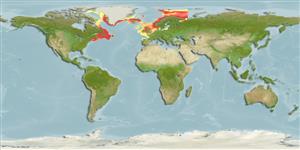Environment: milieu / climate zone / depth range / distribution range
Ecology
Marine; demersal; non-migratory; depth range 7 - 530 m (Ref. 58496). Temperate; 0°C - 12°C (Ref. 35388); 79°N - 41°N, 95°W - 45°E
North Atlantic: Cape Cod on the American coast northward to Ungava Bay, Greenland, Iceland, and the Atlantic coast of northern Europe.
Size / Weight / Age
Maturity: Lm ? range ? - ? cm
Max length : 20.0 cm SL male/unsexed; (Ref. 7297); 15.9 cm SL (female)
Dark spot in the hind part of first dorsal fin, caudal fin with dark stripes. Series of skin folds with serrated edges running obliquely down below the lateral line (Ref. 35388).
Maximum depth reported at 530 m (Ref. 58426). In the Barents Sea usually between 100 to 200 m at temperatures of 1°-3°C and salinities not less than 34 ppt; in the White Sea in somewhat shallower waters at temperatures between 6-12°C and salinities of 23-29 ppt. Prefers sandy bottoms (Ref. 7297). Benthic to epibenthic (Ref. 58426). Feeds on polychaetes and crustaceans (Ref. 35388).
Life cycle and mating behavior
Maturities | Reproduction | Spawnings | Egg(s) | Fecundities | Larvae
Pietsch, T.W., 1993. Systematics and distribution of cottid fishes of the genus Triglops Reinhardt (Teleostei: Scorpaeniformes). Zool. J. Linn. Soc. 109:335-393. (Ref. 7297)
IUCN Red List Status (Ref. 130435)
Threat to humans
Harmless
Human uses
Fisheries: of no interest
Tools
Special reports
Download XML
Internet sources
Estimates based on models
Preferred temperature (Ref.
123201): 0.5 - 8, mean 4.2 °C (based on 699 cells).
Phylogenetic diversity index (Ref.
82804): PD
50 = 0.5010 [Uniqueness, from 0.5 = low to 2.0 = high].
Bayesian length-weight: a=0.00676 (0.00300 - 0.01523), b=3.17 (2.98 - 3.36), in cm total length, based on LWR estimates for this (Sub)family-body shape (Ref.
93245).
Trophic level (Ref.
69278): 3.5 ±0.5 se; based on diet studies.
Resilience (Ref.
120179): Low, minimum population doubling time 4.5 - 14 years (Fec=100).
Fishing Vulnerability (Ref.
59153): Moderate vulnerability (39 of 100).
Nutrients (Ref.
124155): Calcium = 85.8 [35.9, 190.5] mg/100g; Iron = 0.423 [0.197, 0.939] mg/100g; Protein = 17.3 [15.2, 19.5] %; Omega3 = 0.751 [0.319, 2.155] g/100g; Selenium = 18.5 [8.7, 45.3] μg/100g; VitaminA = 18.5 [5.2, 62.4] μg/100g; Zinc = 0.697 [0.454, 1.197] mg/100g (wet weight);
